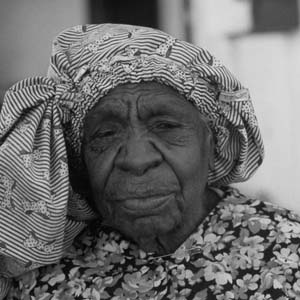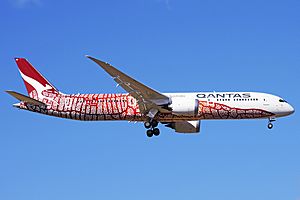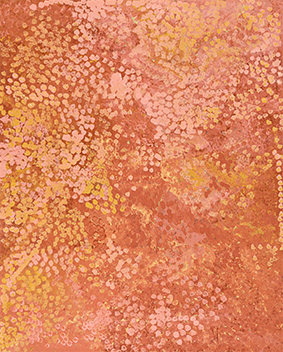Emily Kame Kngwarreye facts for kids
Quick facts for kids
Emily Kame Kngwarreye
|
|
|---|---|
 |
|
| Born | 1910 |
| Died | 3 September 1996 (aged 85–86) Alice Springs, Northern Territory, Australia
|
| Other names | Emily Kam Ngwarray, Kngwarreye, Emily Kame Kngarreye |
| Known for | Painting, contemporary indigenous Australian art |
Emily Kame Kngwarreye (or Emily Kam Ngwarray) (pronounced like Em-i-lee Kahm Nung-wuh-ray) (1910 – 3 September 1996) was a very important Aboriginal Australian artist. Born around 1910, she lived most of her life in the remote Utopia region of central Australia. What makes her story extra special is that she didn't start painting seriously until she was in her 70s! Even though she started late, she became one of the most famous and successful Indigenous Australian artists ever. In just eight years, she created thousands of paintings. Her art is known for its bright colours, energetic lines, and dots, and shows her deep connection to her homeland and culture.
Contents
Early life
Emily Kame Kngwarreye was born in a place called Alhalkere, which is part of the Utopia Homelands. This area is about 250 kilometres (that's about 155 miles) northeast of a town called Alice Springs. Her family belonged to the Anmatyerre language group. She was the youngest of three children.
Growing up, Emily lived a traditional life connected to her country. She also worked on cattle stations, which are large farms where cattle are raised. In June 1934, she moved to the MacDonald Downs Homestead, not too far from her birthplace, to help with work around the house and with the cattle.
Emily had no children of her own, but she was closely connected to her family. Her sister-in-law was another artist named Minnie Pwerle, and Minnie's daughter, Barbara Weir, was like a daughter to Emily. Emily was a guardian for Barbara for several years. Her great-niece, Jeannie Pwerle, and her brother's children, Gloria Pitjana Mills and Dolly Pitjana Mills, are also painters. This shows how art and culture were important parts of her family and community.
Emily's deep connection to her homeland, Alhalkere, was the heart of her art. She knew every part of the land – the plants, the animals, the waterholes, and the stories connected to them. This knowledge and love for her Country became the main subject of her paintings.
Becoming an artist
Emily had been involved in creating art for ceremonial purposes for many years as an elder. She was known for being very precise and detailed in her traditional designs.
In the 1970s, Emily and other women in the Utopia community had the chance to learn new art techniques through adult education courses. One of these techniques was batik. Batik involves drawing designs on fabric with hot wax and then dyeing the fabric. The wax resists the dye, creating patterns. Emily started learning batik in 1977 and worked with it for about 11 years. She became part of the Utopia Women's Batik Group, which started in 1978 with about 21 women. This group was important because it helped Aboriginal women artists develop their own styles. Emily's batik work already showed some of the things she would paint later, like designs based on body painting (called awelye), emus, lizards called goannas, and other plants and animals from her home.
Then, in 1988, something exciting happened. Emily was introduced to acrylic paints and canvas. This was part of a project called "A Summer Project," where artists in Utopia were given canvases and paints to try this new medium. Emily quickly fell in love with acrylics. She found it easier than batik, which required a lot of boiling the fabric to remove the wax – something that was hard work, especially as she got older and her eyesight wasn't as good.
Painting on canvas allowed Emily to work in a new way. She would often place large pieces of canvas on the ground and sit on them, using a long brush to reach across and paint. She was incredibly productive, creating more than 3,000 paintings in just eight years! That's about one painting every day! This amazing amount of work made her one of the most prolific artists in Indigenous Australian art history.
Style and subjects

Emily Kame Kngwarreye's art is instantly recognisable and full of energy. Her style changed over the years, but it was always rooted in her connection to her country and the Anmatyerre people's understanding of The Dreaming. The Dreaming is a very important concept for Aboriginal people; it's like a moral code and explains how the world was created by ancestral heroes who travelled the land. The designs Emily used in her paintings were often based on the marks painted on sand or bodies during ceremonies, which are like a way of re-enacting the journeys of these ancestors.
When she first started painting with acrylics in the late 1980s, Emily used colours like red, yellow, black, and white, which are traditional colours. By 1990, she started using more colours like grey, purple, and brown, which made her paintings feel even more atmospheric.
One technique she often used was overlapping masses of tiny dots. This style is also seen in the work of other artists from the Desert Art Movement and can create an effect that looks like the shimmering heat you see in the desert. She also used an aerial perspective, which is like looking down on the land from above.
In 1992, Emily started connecting her dots to form lines. She created colourful parallel lines, both horizontal and vertical, which could represent things like rivers or the landscape of the desert. She also started using bigger brushes, which made her dots larger and less intricate.
Later, around 1993, she began adding patches of colour alongside the dots, sometimes creating colourful rings. She even used a shaving brush for a technique she called "dump dump," using very bright colours.
In the mid-1990s, towards the end of her life, she started painting with thick stripes of paint. These stripes might look abstract, but they were actually based on awelye, the designs painted on women's bodies for ceremonies. These interwoven lines often represented the track lines of important plants like the yam.
The subjects of Emily's paintings were always about her country, Alhalkere. She painted the "essence" of her region, including:
- Arlatyeye (pencil yam)
- Arkerrthe (mountain devil lizard)
- Ntange (grass seed)
- Tingu (a Dreamtime pup)
- Ankerre (emu)
- Intekwe (a small plant that emus like to eat)
- Atnwerle (green bean)
- Kame (yam seed pod)
The pencil yam was especially important to her. It was a vital food source, and her middle name, Kame, refers to the yellow flower and seeds of this plant. She often started her paintings by putting down the lines that represent the yam tracks.
While some people in the art world saw her work as similar to Western art styles like modernism or abstract expressionism, Indigenous Australian experts argue that her art is deeply connected to ancient Aboriginal traditions and her relationship with her country.
Recognition and exhibitions
Emily Kame Kngwarreye's talent was quickly recognised. Even though she started painting late in life, her work was shown in many important exhibitions.
Her batik work was first shown publicly in 1980. In 1981, an exhibition of batik called "Floating Forests of Silk" featured her work and travelled to different places.
Her first solo exhibition, where only her work was shown, was held in 1990 at Utopia Art Sydney.
Emily received significant recognition during her lifetime. In 1992/1993, she was given an Australian Artist's Creative Fellowship by the Australian government, led by Prime Minister Paul Keating at the time. This was a special award to support artists.
A huge honour came in 1997, after her passing, when she was chosen to represent Australia at the Venice Biennale, a very famous international art exhibition in Italy. She was featured alongside two other important Indigenous artists, Yvonne Koolmatrie and Judy Watson. Their exhibition was called "Fluent" and showed the diverse experiences and art practices of Aboriginal artists.
Many major galleries and museums in Australia and around the world have shown Emily's work. The Queensland Art Gallery held the first major look back at her career (called a retrospective) in 1998. This exhibition travelled to other big galleries in Australia.
Another major retrospective, "Utopia: The Genius of Emily Kame Kngwarreye," was held in 2008 and travelled from Japan to the National Museum of Australia in Canberra.
More recently, in January 2023, the National Gallery of Australia in Canberra opened a major exhibition focusing on how Emily's paintings are connected to her country, community, and traditional knowledge. This exhibition, co-curated by Aboriginal curators, aimed to show that her art is deeply rooted in ancient Aboriginal practices, not just Western abstract styles.
Her work is held in the collections of major institutions like the National Gallery of Australia, the National Gallery of Victoria, the Art Gallery of New South Wales, and even the Tate Gallery in London.
Art
Because Emily's art became so popular and celebrated, it also became very valuable. Her paintings have sold for high prices at auctions. For example, in 2007, one of her paintings called Earth's Creation I sold for over a million Australian dollars, setting a record for an Australian female artist at the time. It sold again in 2017 for an even higher price!
The high demand for Indigenous art in the 1990s also brought challenges. Unfortunately, some people tried to take advantage of the situation. There were reports of inexperienced or even dishonest art dealers. Emily herself was aware of this and reportedly said that people looking for quick money were encouraging the creation of poor-quality paintings.
After her death, there were also reports that some paintings said to be by Emily were actually fakes. This is a problem that can happen when an artist's work is very popular and valuable.
There have also been discussions in the art world about the influence of Emily's style. In 2018, there was a conversation about whether the work of British artist Damien Hirst looked very similar to Emily's style. While Hirst said he didn't know about her work and that his style was based on other art movements, some people from the Utopia community felt the similarities were too close to be a coincidence.
Legacy
Emily Kame Kngwarreye broke barriers as a female Indigenous artist who achieved international fame starting late in life. Her powerful and expressive paintings opened the eyes of many people around the world to the beauty and depth of Aboriginal Australian art and culture. Her work continues to inspire artists and educate people about the importance of Country and the enduring strength of Indigenous traditions.
Awards
- Australian Artist's Creative Fellowship, Australia Council, 1993.
- Inducted into the Victorian Honour Roll of Women, 2001.
See also
 In Spanish: Emily Kame Kngwarreye para niños
In Spanish: Emily Kame Kngwarreye para niños
- Australian art
- Indigenous Australian art


